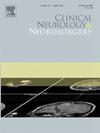神经内镜手术治疗脑干出血:技术说明和初步临床结果。
IF 1.8
4区 医学
Q3 CLINICAL NEUROLOGY
引用次数: 0
摘要
背景:脑干出血在自发性脑出血中所占比例较小(10%),但往往发生在生命早期,预后较差。大量研究支持微创血肿清除术对脑内出血的治疗潜力,但对脑干出血的益处评估却很少:我们评估了在神经内镜引导下采用气动臂固定的微创方法清除严重脑干出血患者血肿的安全性和有效性。研究纳入了苏州大学附属第九医院确诊为原发性脑干出血并接受神经内镜辅助清除术治疗的14例患者。收集并分析了相关的临床和预后数据:术前CT显示血肿量为8至13 mL,入院时GCS为4至6。平均手术时间为 157 分钟,术中平均失血量为 86 毫升。术后立即进行的 CT 显示,所有患者的血肿清除率均令人满意(超过 90%)。术后重症监护室平均住院时间为 9.5 天,呼吸支持平均为 7.5 天。由于肺部感染和咽反射消失,11 名患者需要进行气管切开术。9名患者的功能恢复令人满意(GOS评分为4分和3分),5名患者仍处于植物状态(GOS评分为2分):结论:神经内窥镜可直接观察脑干血肿,为安全可靠的血肿清除提供了良好的条件。新PPH评分为2分或3分的患者更有可能从手术治疗中获益。需要进行大规模研究,以确定最有可能从这项技术中获益的患者。本文章由计算机程序翻译,如有差异,请以英文原文为准。
Neuroendoscopic surgery for brainstem hemorrhage: Technical notes and preliminary clinical results
Background
Brainstem hemorrhage accounts for a relatively small proportion of spontaneous intracerebral hemorrhages (∼10 %) but tends to occur earlier in life and has poorer prognosis. Numerous studies support the therapeutic potential of minimally invasive hematoma evacuation for intracerebral hemorrhage; however, there have been few assessments of the benefits for brainstem hemorrhage.
Methods
We evaluated the safety and efficacy of a minimally invasive approach under neuroendoscopic guidance with pneumatic arm fixation for removing the hematoma in severe brainstem hemorrhage patients. 14 patients diagnosed with primary brainstem hemorrhage and treated by neuroendoscopy-assisted evacuation at Suzhou Ninth Hospital affiliated to Soochow University were included in the study. Relevant clinical and prognostic date were collected and analyzed.
Results
Hematoma volume ranged from 8 to 13 mL according to preoperative CT, while GCS at admission ranged from 4 to 6. The average operative time was 157 min and average intraoperative blood loss was 86 mL. All patients achieved satisfactory hematoma evacuation (over 90 %) according to immediate postoperative CT. Postoperative intensive care unit stay averaged 9.5 days and respiratory support averaged 7.5 days. 11 patients required tracheotomy due to pulmonary infection and absence of pharyngeal reflexes. 9 patients achieved satisfactory functional recovery (GOS score of 4 and 3), while 5 remained in a vegetative state (GOS score of 2).
Conclusion
Neuroendoscopy provides excellent direct visualization of brainstem hematomas for safe and reliable evacuation. Patients with a new PPH score of 2 or 3 are more likely to benefit from surgical treatment. Large-scale studies are required to identify patients most likely to benefit from this technique.
求助全文
通过发布文献求助,成功后即可免费获取论文全文。
去求助
来源期刊

Clinical Neurology and Neurosurgery
医学-临床神经学
CiteScore
3.70
自引率
5.30%
发文量
358
审稿时长
46 days
期刊介绍:
Clinical Neurology and Neurosurgery is devoted to publishing papers and reports on the clinical aspects of neurology and neurosurgery. It is an international forum for papers of high scientific standard that are of interest to Neurologists and Neurosurgeons world-wide.
 求助内容:
求助内容: 应助结果提醒方式:
应助结果提醒方式:


